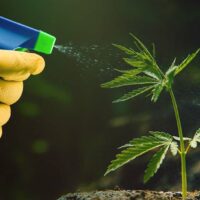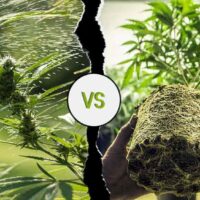“The more regenerative farming occurs for all crops, the less carbon dioxide will be in the atmosphere. Farmers are in a unique position to decrease the trajectory towards massive climate change using these practices.”
These are the enlightening words of Dr. Jade Stefano. The last time we spoke to her, she was excited to announce that her farm had just obtained a “Sun+Earth” certification for regenerative farming. The matter seemed important and deserving of more coverage by Greencamp.
According to Dr. Evan Mills, the founder of Energy Associates and a member of the international body of scientists (IPCC) that collectively shared the 2007 Nobel Peace Prize with former US Vice President Albert Arnold (Al) Gore Jr., “a single cannabis ‘joint’ represents about 10 pounds of CO2 emissions, or an amount of electricity equal to running a 100-watt light bulb for 75 hours with average US electricity.”
That’s how urgently we need to talk about regenerative cannabis farming.
Regenerative Vs. Sustainable Cannabis Agriculture
Regenerative agriculture is a set of principles and practices that stem from a holistic approach to growing plants, and basically come down to the fact that cultivation should not only sustain the natural resources (soil, water, biodiversity) but seek to amend them.
The concept was present for centuries until it was replaced with commercial farming in order to produce large yields.
Now, after years of industrial farming and its negative environmental footprint, this “conscious” cultivation is not only desirable but necessary.
“It has been said that ‘sustainability is no longer enough’. This is true. The ability of our planet to provide life for future generations has already been so damaged that remaining at our current level of operations will not be possible. Sustaining the status quo will not end well,” Stefano explained.
“Regenerative farming goes further than sustainability, by not only preserving the soil and the environment for future generations in its current condition (not depleting it further), but by regenerating it for a net gain in soil fertility, carbon banking, and biodiversity,” she added.
“It eventually translates to securing long term food production, along with the ability for humans to continue to live in nice conditions on planet Earth. When you think of it this way, it’s a no brainer,” was her concise conclusion.
Environmental Stewardship
As soon as it became available for cannabis cultivation to come out of the basements, there was no more justification for prodigious energy use (Dr. Mills calculates that the energy expenditures for indoor cannabis production are $6 billion each year — more than what is spent on energy to make all pharmaceuticals consumed in the US).
“Ironically, the plant that can heal the world is being cultivated on a massive scale which utilizes energy loads high enough to power entire cities,” Stefano commented.
Of course, it means that a great deal of damage has already been done.
“Regenerative farming seeks to repair the damage that has already been done at a local and global level. Locally, this looks like planting trees, utilizing cover crops, minimizing soil disturbances, restoring ecosystems, and increasing biodiversity on the farm, among other things,” Stefano clarified.
“Subsequently, these activities also regenerate the global system. By removing carbon dioxide from the atmosphere and sequestering it in soil and vegetation, the trajectory of climate change resulting from human released carbon dioxide is nudged down. Instead of having a net carbon release that increases climate change, regenerative farming is net carbon negative,” she pointed out.
Regenerative Principles and Practices
By definition, a regenerative agricultural practice is one with the goal to increase biodiversity, enrich the soil, improve watersheds, and enhance ecosystem services.
More poetically said, it’s the flourishing of life on a cannabis farm. And it usually results in more quality buds.
The best thing is that it is a scalable concept, Stefano noted.
“Farmers who are not using these practices can slowly change over. I do not believe in ‘all or nothing’ thinking. Sometimes a slow transition to a regenerative system can be less frightening for farmers.”
When we asked her to describe the practices they were using on the farm, Dr. Stefano was more than enthusiastic.
“For one thing, growing under the sun means that we do not use excessive and unnecessary amounts of energy generated from fossil fuels nor damaging hydroelectric projects. Indoor grown cannabis is the most energy-intensive crop known to humankind,” she said.
“One of the most important regenerative practices on our farm is the use and production of Biochar. It’s inorganic carbon made by using a cool slow charcoal process. The resulting coal is added to the soil and the carbon contained within it will never break down and release CO2,” explained Stefano.
“This is a way to permanently sequester CO2 from the atmosphere, while simultaneously increasing the health of your soil, because it acts as a hotel for microbial life. Its structure provides a backbone for living organisms to reside and further increase fertility and carbon storage,” she went in more detail.
She added that they grow and use cover crops such as vetch and clover, which allows them to pull inorganic nitrogen from the air and the plants are able to turn it into usable organic nitrogen. That way they avoid using fertilizers that damage the environment.
The nitrogen cycling this way is a perfect example of how nature itself creates a “closed-loop economy”.
“When the plants die and are incorporated into the soil, they release their nitrogen, thus increasing the soil’s fertility and reducing or sometimes eliminating the need for exogenous fertilizer,” Stefano said.
All in all, it seems that a lot of these practices come down to allowing mother nature to operate in a friendly environment.
Constructive Capitalism
The concept of regenerative farming is often associated with the insistence on social fairness and equity among people who farm the plant. This is sometimes referred to as “constructive capitalism”, but it seems that it has a whole lot to do with socialism as well.
Namely, every “regeneratarian” will tell you that caring for the entire farming community is equally important as preserving the ecosystem. From a holistic perspective, human empowerment is one of the pillars that ensure the entire construction of regenerative agriculture stands firmly on motivated hard work.
“We firmly believe that capitalism is possible without environmental and social destruction,” Stefano said.
And she is also thankful to Dr. Bronner’s and Brother David’s who continue to support farms such as her own and keep fighting against the industrialization model that’s usurping the cannabis industry. But that’s a story of its own.
“Brother David’s donates its profits to fund the Sun+Earth non-profit and subsidize certification costs for small cannabis farms using regenerative farming processes. Since certification can cost upward of $4000 for a small farm, it is more than helpful to have this support,” she said.
Final Thoughts
While fighting his own battles, Dr. Evan Mills noticed a funny thing:
“You know you’re in trouble when the marijuana industry’s leading trade journal cites long-debunked claims by coal-industry hacks that the (unrelated) IT sector uses such-and-such amounts of energy as a reason why we somehow shouldn’t worry about the carbon footprint of the indoor pot. Strange bedfellows.”
He’s talking about a claim made by Mr. Mark P. Mills, a Senior Fellow at the Manhattan Institute, that certain cell phones use more electricity per week than two refrigerators in a year, and by extension, he’s claiming that all information technology uses an insane amount of energy.
It was shown that the calculations of Mr. Mark P. Mills were way off, but when a respected marijuana journal reported on it, they tried to attack the “debunker” and deflect the fact that cultivating indoor pot uses lots of energy. Dr. Evan Mills became disappointed with how the industry is handling the issue.
“The industry would do well to be less defensive and more proactive about owning its history and moving forward into a greener future along with the rest of us,” he commented.
He isn’t a farmer, nor a “regeneratarian”. But he is certainly pointing in the same direction and asking the same question – why are we not using and nursing the environmental solution that’s been lying right under our feet for who knows how long now?








Ron Cameron May 6, 2020 at 7:45 pm
as a long time gardener and a grain farmer for a number of years, it took a minute to figure out what was trying to be presented here. The article could be titled " Conscientious Agriculture". Which means " taking care of the land, giving back to the land, in an appropriate, organic, non-chemical way". The "conscientious farmer/gardener" began using this process years ago. In my case since the late '60s. Not the earliest by any stretch. Everything is a variable. All soil is different. Some better than others. It can take years to go from point A, to point B!
David K. July 22, 2020 at 9:30 pm
I guess these days some ideas need rebranding so that we can come across them from time to time. As many names as it is and will be called, I am glad that many of you actual farmers are on the same page!